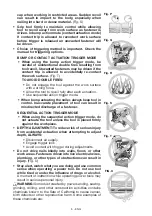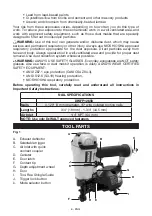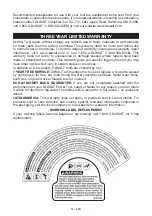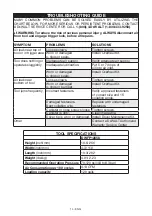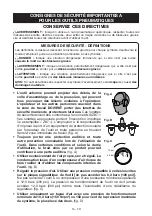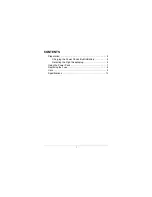
4 - ENG
• Do not overreach. Maintain proper footing and balance
at all times. Loss of balance may cause personal injury.
(Fig. K)
• Make sure hose is free of obstructions or snags.
Entangled or snarled hoses can cause loss of balance
or footing.
• Use the tool only for its intended use. Do not discharge
fasteners into open air, concrete, stone, extremely hard
woods, knots or any material too hard for the fastener
to penetrate. Do not use the body of the tool or top cap
as a hammer. Discharged fasteners may follow unex-
pected path and cause injury. (Fig. L)
• Always keep fingers clear of contact trip to prevent
injury from inadvertent release of nails. (Fig. M)
• Refer to the Maintenance and Repairs sections for
detailed information on the proper maintenance of the
tool.
• Always operate the tool in a clean, lighted area. Be
sure the work surface is clear of any debris and be
careful not to lose footing when working in elevated
environments such as rooftops.
• Do not drive fasteners near edge of material. The
workpiece may split causing the fastener to ricochet,
injuring you or a co-worker. Be aware that the nail may
follow the grain of the wood (shiner), causing it to protrude
unexpectedly from the side of the work material. Drive the
nail perpendicular to the grain to reduce risk of injury. (Fig. N)
• Do not drive nails onto the heads of other fasteners
or with the tool at too steep an angle. Personal injury
from strong recoil, jammed fasteners, or ricocheted
nails may result. (Fig. O)
• Be aware of material thickness when using the nailer.
A protruding nail may cause injury.
• Be aware that when the tool is being utilized at
pressures on the high end of its operating range,
nails can be driven completely through thin or very
soft work material. Make sure the pressure in the
compressor is set so that nails are set into the
material and not pushed completely through. (Fig. P)
• Keep hands and body parts clear of immediate work
area. Hold workpiece with clamps when necessary to
keep hands and body out of potential harm. Be sure
the workpiece is properly secured before pressing the
nailer against the material.
The contact trip may cause the
work material to shift unexpectedly. (Fig. Q)
• Do not use tool in the presence of flammable dust,
gases or fumes. The tool may produce a spark that
could ignite gases causing a fire. Driving a nail into
another nail may also cause a spark. (Fig. R)
• Keep face and body parts away from back of the tool
Fig. K
Fig. L
Fig. M
Fig. N
Fig. O





